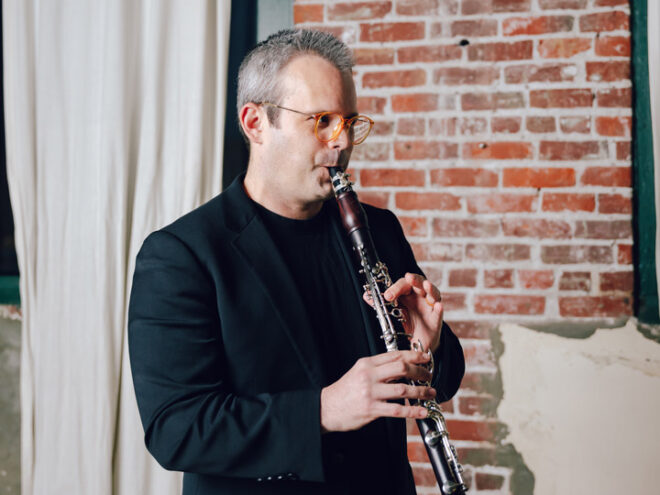James Shields: Deep Dive Into Baroque Music

One half of All Classical Radio’s 2024-2025 Artists in Residence, James Shields, takes a deep dive into the history of Baroque music.
As a clarinet player and a lover of Baroque music, it pains me that my instrument was not fully established during the era of Bach and Vivaldi. The clarinet is generally considered to have come into existence roughly around 1700 and evolved from a wonderful little Baroque instrument called the chalumeau. Composers such as Vivaldi, Telemann, and Graupner wrote for that instrument, which somewhat resembles a recorder with a reed. Both the clarinet and the chalumeau have similar bore designs, and the clarinet’s predecessor makes a remarkably similar sound to the modern clarinet when handled by a skilled musician.
You can learn more about the chalumeau in this YouTube video:
The true clarinet existed during the height of the Baroque Era, but the most well-known composers of the time left us no music for the instrument. So, what’s a Baroque-loving clarinetist to do? First, let’s look at the music of JS Bach, beginning with some unaccompanied music that I have played almost daily for the past 20 years: the six Cello Suites and the six Violin Sonatas and Partitas. These works can be immensely rewarding and powerful educational tools for clarinetists of intermediate and advanced levels, giving both budding and seasoned performers a perfect vehicle to practice tone, legato, articulation, phrasing, rubato, intonation, and more. While many of these movements contain extensive chord writing, most can be readily adapted to the clarinet.
I’ve performed all six Cello Suites on the bass clarinet (gasp!), and I think with a thoughtful approach these masterpieces can come off quite well on the instrument. Suites 1, 2, and 3 are technically more straightforward, in easier keys, and include fewer double and triple stops than the later suites. All three of these earlier suites can provide a great challenge for high school and college aged enthusiasts and are great life-long refresher works for professionals and dedicated amateurs looking to maintain and refine their skills. The final three suites are more challenging. They contain more leaps, more complicated passage work, are longer, and perhaps most challengingly contain much more extensive use of chords. The 6th suite was written for a 5 string “piccolo cello” and as a result has a wider range than the other suites. This presents a unique challenge that will push even many accomplished bass clarinetists to work on refining their high-register finesse.
Hear my rendition of Bach’s Suite No. 1, Mvts 1-3 on YouTube:
Compared to the Cello Suites, the six Violin Sonatas and Partitas are more of a challenge to translate to the clarinet. Of these works, I’ve only publicly performed the Partita in B minor, and it was one of the more difficult challenges I’ve taken on. All six of these works have extensive use of double, triple, and quadruple stops and are generally more virtuosic than the Suites for Cello. Many movements from the Sonatas in G minor and C major, and the Partitas in B minor and D minor, are in my weekly etude rotation. I use these works as the best music to practice evenness of tone, legato, intonation, and the never-ending challenge of creating an inherently engaging performance style that is both clear and subtle. Bach is the best!
While there are many wonderful editions out there prepared specifically for clarinet, I encourage students to use the original scores for cello and violin, rather than adaptations. We can make our own choices on how to roll or break chords that are not possible on the clarinet by looking directly at the source material, rather than assuming the choices of an editor. Many Baroque specialists chose to roll chords even on violin, so I have learned not to lose sleep over it. As far as transposition – who cares? We are playing violin and cello works on the clarinet and bass clarinet, so I think it’s too late for authenticity in certain respects. Clarinetists do need to be able to transpose on sight, so if you really want to play the same sounding pitches as your violinist friends, go ahead and read from the original versions as though you were performing a part for Clarinet in C and you can get some transposition practice while you are at it.
As far as performing other Baroque works on the clarinet, Telemann’s works for chalumeau translate fairly well to the modern clarinet. The Concerto in D minor for 2 chalumeau, strings, and basso continuo can work well on modern instruments. I’ve performed this Concerto several times in what I’d describe as a “middle path” stylistic approach adopting aspects of historically informed performance practice with a mixture of modern and Baroque equipment.
Recently, the acclaimed Swedish Clarinet Soloist Martin Fröst worked with arranger Andreas Tarkmann and Concerto Köln to release a wonderful album of Imaginary Concertos inspired by the question, “What if Vivaldi had written concertos for the clarinet?” The three concertos often draw on Vivaldi’s operatic works, using vocal arias as source material. This approach works fantastically in my opinion, and Tarkmann has created three satisfying and dramatic works that show off the clarinet’s blend of virtuosic and vocal qualities.
My general feeling about Baroque music, or music in general, is that it’s all fair game! Whether you’re looking for a tool to push yourself in the practice room or some new music for the concert stage, I think the clarinet can mix with Baroque Era music brilliantly. With a little care and attention to style, audiences will appreciate your adventures with adapting the music from the pre-clarinet era for this versatile instrument.

ABOUT
Clarinetist James Shields is one half of All Classical Radio’s 2024-2025 Artists in Residence, along with his wife, violinist Emily Cole.
James joined the Oregon Symphony in 2016 after holding similar positions in the Canadian Opera Company and the New Mexico Philharmonic. A Juilliard graduate, he has appeared as soloist with the Oregon Symphony, New Mexico Philharmonic, and Music in the Mountains (CO), and has performed as guest principal clarinet of the Philadelphia Orchestra and the Malaysian Philharmonic.
In addition to his performing activities, James holds a master’s degree in Composition and Music Theory from the University of New Mexico and composes regularly.
Learn more about Emily and James on the All Classical Arts Blog.
Read other posts by All Classical Radio




